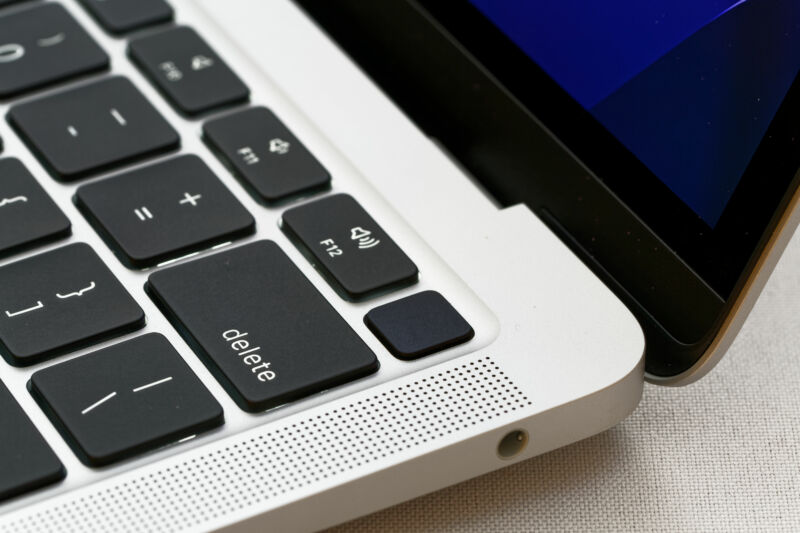
The new M1-powered MacBook Air is hilariously fast, and the battery lasts a long-ass time.
If you stop reading this review immediately after this, then know that unless Windows virtualization is a requirement of your workflow, you should probably just go ahead and sell your old MacBook Air immediately and get this thing instead.
Assuming you've got a grand or so lying around that you weren't going to spend on something else. But hey, if you do, then I can confidently tell you that in spite of what a legion of Doubting Thomases (including me!) might have said about Apple's freshman effort at its own PC silicon, it is now my studied opinion that there are far, far stupider ways to part with your cash.
A quick caveat on this “review”
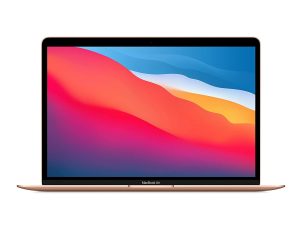
Apple MacBook Air (late 2020)
Apple provided Ars with a couple of M1 Mac Minis for review. One of those went to Samuel for him to write up, and the other went to Jim for him to do his silicon analysis. Apple declined our request for any model of M1-powered laptop.
The MacBook Air being reviewed here is my personal device, which I bought shortly after the unveiling event. I've written this as quickly as possible after receiving it, but I had to wait for the device, which is why you all had to wait for the review. (This is also why it's in kind of an intermediate configuration, rather than stock or maxed out like most review devices—I bumped the RAM up to 16GB and the internal storage up to 1TB, because that's what I wanted.)
Because this is my device, I'm coming into this review from a slightly different perspective than some of the other publications doing MBA reviews. I'm not going to tell you why you should buy a MacBook Air, or how it might work for you. But I am going to talk about what it has been like to own it for a few days and how the device fits into my life. I do most of my power-user stuff on the desktop rather than on a portable, but I do occasionally need to leave the office and hit the road—and the M1 MBA is going to be a great traveling companion. You know, once we can hit the road again without worrying about plagues and stuff.
| Specs at a glance: 2020 MacBook Air (M1) | |
|---|---|
| Screen | 2560×1600 at 13.3 inches |
| OS | macOS Big Sur 11.0.1 |
| CPU | Apple M1 |
| RAM | 16GB |
| GPU | Apple M1 (8 core) |
| HDD | 1TB SSD |
| Networking | 802.11ax Wi-Fi 6; IEEE 802.11a/b/g/n/ac; Bluetooth 5.0 |
| Ports | 2x Thunderbolt 3/USB 3.1 Gen 2/DisplayPort, 3.5mm headphone |
| Size | 0.16–0.63×11.97×8.36-inch (0.41–1.61×30.41×21.24cm) |
| Weight | 2.8 lbs (1.29kg) |
| Warranty | 1 year, or 3 years with AppleCare+ |
| Price as reviewed | $1,299 |
| Other perks | 720p FaceTime HD camera, stereo speakers |
Unboxinating
Approaching a device like this as a reviewer is different from approaching a device as a consumer. When the UPS guy drops it off, you can't just rip the box open and jump in—there's stuff you have to do first.
Tripods. Lights. Gotta iron the big white sweep cloth so I've got a background for pix. Gotta try to remember where the DSLR battery is.
It's the oddest part about working for Ars, even after going on eight years. Your technology buying experiences are not always your own—sometimes the Ars readership comes along for the ride.
So after unboxing, I logged on and ran some benchmarks. That's the first thing you have to do when you're reviewing—you either do the benchmarks first, or you do them dead last, and I wanted to get them out of the way because this was, you know, my laptop, and I'd actually like to use it for stuff rather than having it be tied up running battery tests for 20 hours at a time.
-
This is the box that it comes in.Lee Hutchinson
-
This is everything that's inside the box. (Well, almost everything—you get an actual laptop, too.)Lee Hutchinson
-
2015 13-inch i7-powered MacBook Air at left, 2020 13-inch M1-powered MacBook Air at right.Lee Hutchinson
-
The older MacBook Air design is a little bulkier, even though the screens are the same size.Lee Hutchinson
-
A tale of two laptops.Lee Hutchinson
-
Out with the old, in with the new. (If anyone wants to grab a copy of the awesome Last Starfighter wallpaper on the old MBA, I got it from this reddit thread.Lee Hutchinson
Only a few days earlier, I had used my living room HTPC—a base-config 2018 Mac mini—to do the entire set of Mac comparison benchmarks for Samuel's Mac mini review. I had a pretty good feel for how quickly the Intel mini's hex-core i5 banged through each of the tests, since I'd just seen the numbers, and from talking to Samuel and Jim I was anticipating the new MBA's M1 would beat the Intel-powered mini.
I just didn't realize how hard a beatdown it would be.
Getting the benchmarky bits out of the way
So here's how fast it is in a bunch of charts and graphs.
According to Apple, the MacBook Air's M1 is voltage-limited in order to function within the fanless design's thermal envelope. iFixit's teardown shows in detail that the Air's M1 cooling setup is an entirely passive affair, with just a heat transfer plate in between the M1 CPU and the aluminum body. I was expecting performance similar to but perhaps a bit lower than the M1-powered Mac mini, and that's more or less what I got. However, the Air's M1 is good for at least a few solid minutes of full-bore Firestorm core performance before it throttles back.
In benchmarking, I noticed that subsequent runs of the Final Cut Pro export would slow down dramatically—the first export would complete in about 1 minute and 19 seconds, but if I immediately repeated the export it would take a bit under 2.5 minutes—and the Air would be quite warm to the touch. After closing the lid to hibernate until the Air was cool and then repeating the export, the time was once again in the 1:20-ish range.
To create some more sustained load, I cloned the source video three times and then repeated the export process. Starting from a cold startup with the MBA's chassis at ambient temperature gave a result of 4 minutes, 21 seconds. This time, I opened Activity Monitor's CPU graph to spy on the core utilization. All eight cores were engaged until about 2:56, at which time half of the cores—presumably the high-performance Firestorm cores—dropped to less than 50-percent usage and stayed there until the run completed.
-
Starting a long export with all four cores blazing away.
-
But after a few minutes, four of the cores—presumably the high-performance Firestorm ones—throttle themselves back.
A second run immediately after that took 7:37—not quite twice as long, but heading in that direction. Activity Monitor's CPU usage graph showed half of the cores (presumably the high-performance Firestorm cores) at half utilization for the entire run.
Further testing—including several runs after letting the MBA sit powered off for about an hour to make absolutely sure it was cooled to ambient—failed to produce anything resembling a precise, repeatable time interval for when throttling starts. The best I can do is to say that it seems that when you throw a heavy workload at the MBA, it runs at full-bore until the Firestorm cores become too toasty, which seems to take anywhere from 3-ish to 6-ish minutes. Then it backs the Firestorm cores off until they show about 50-percent utilization, and the amount of heat generated at that level seems to be within the sustained thermal capacity of the design.
(These are subjective measurements, taken in whatever indoor ambient conditions happened to be happening in my house as I was doing the testing. Your results may vary.)
I hate USB-C charging, give me back MagSafe
The other major thing for a portable like the MBA is battery life, and we're going to talk about that. But first, very briefly, the loss of MagSafe sucks.
Yes, I know I'm late to the discussion. I know MagSafe was deleted a few hardware revisions ago, but I'm going from a MacBook Air with it to a MacBook Air without it, and plugging in a USB-C cable feels like going back to the freaking dark ages. I've been happy with MagSafe plugs on my laptops for almost an entire decade—that quick one-handed snick into place, that easy no-fuss pull to disengage, and that friendly LED to tell you when you're all charged up.

Having to shove a connector into a high-friction plug—often requiring two hands, depending on how you're holding stuff—is stupid. It's just stupid. This is a customer-hostile regression in functionality. I'm sure there are excellent reasons for it and that it saves Apple money on the MBA's bill of materials and on warranty support, but I hate it and it's terrible. This is not the premium Apple experience I feel like I'm paying for.
Battery life
I used the M1 MacBook Air for work all day one day, filling up about 11 hours of on-the-clock time with Slack, emailing, Zoom conferencing, Messages, and Web browsing, and the Air still had 40 percent remaining on the battery meter when the day was done. This is considerably longer than my old 2015 MBA, which throws in the towel around hour five. (Unlike with the official battery test, my unofficial workday usage test was done with adaptive brightness and Night Shift enabled, and there was a fair amount of idling.)
In the official Ars battery test, with the screen locked at our reference brightness of 200 nits, the M1 MBA lasted for 877 minutes—a bit over 14.5 hours. Charge time back from almost dead to full took a bit over two hours with the included 30W adapter, with the device powered off during the charge.
But I don't usually spend the day working on my laptop—instead, the place where my old MBA most often lets me down is on long flights. Living in Houston means I usually fly United, and United is particularly miserly with power plugs—if you don't get certain specific seats, you're out of luck. In my experience, my Intel MBA is good for three, maybe four hours of movie watching before it's dead as a doornail—so if I'm flying to California or pretty much anywhere that's more than a couple of hours away and I don't get a power outlet seat, I know I probably need to bring a book.
The M1 Air laughs at my old MBA. It laughs at it, gives it noogies, and flushes its head down the toilet in the locker room.

I left the M1 MBA playing 4K Westworld episodes from the UHD BluRay box set, full screen and at max brightness, with the sound blaring at max volume. I finally gave up and shut the laptop off after ten hours, at which point it still said it had 13-percent battery remaining. That's not only long enough to last out any domestic flight—that's enough to last you an international flight from the US to Europe.
A quick note on resuming from sleep: during the Air's reveal, Apple showed off how quickly the Air resumes from standby by having Senior VP Craig Federighi lift the lid of a sleeping MacBook Air and peek in, all set to the mellow sounds of Barry White. While I can't say that Barry White plays when I open up my laptop, I can say that the M1 Air wakes from sleep very quickly. It's not that it's faster than my Intel-powered Air, since the 2015 model will sometimes wake up instantly, too—but the 2015 Air also sometimes takes a second or two to blink on when I lift the lid. The M1 Air is much more consistent—I've only had the thing for a few days, but every wake-from-sleep has been lightning quick.
New silicon, old apps
As has been explained by folks who are smarter than I am, the new M1 does not natively run x86 applications. Therefore, as with the last big architecture transition, Apple has created a bytecode translator that can make your Intel applications work on Apple Silicon. It's called Rosetta 2, and it works pretty well.The first time you run an x86 application, you'll be prompted to download Rosetta 2; after that, launching an x86 application is just like launching an Apple Silicon app—you click on it and it runs.
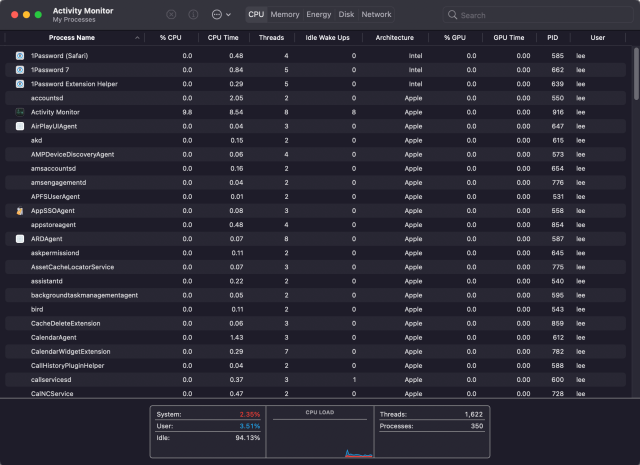
My laptop workflow doesn't use many apps, but I am a long-term Firefox user—and unfortunately, the x86 version of Firefox seemed to exhibit a bit of stage fright. Specifically, after installation and startup, Firefox 83 would work fine for the first couple of webpages, and then just… stop loading stuff. It would sit with the "Waiting for..." notice in the status bar, like it was going to load the page, and never get to the next step. Trying to quit the browser would lead to the Firefox process going unresponsive. After killing and relaunching it, the browser would work fine again for a couple of pages and then do the same thing.
Rather than troubleshoot, I fixed the issue by downloading the beta release of Firefox 84, which includes native Apple Silicon support. The problem behavior vanished, and everything worked fine.
The other Intel apps I tried, including Slack, 1Password 7, Dropbox, and a 64-bit community port of Boxer, all worked transparently and without issue. (There were also no problems using 1Password's extension inside of Firefox, Chrome, or Safari.) Running old Sierra games under Boxer worked fine—and, if I'm being honest, running old Sierra games under Boxer is about half of what I actually do use my laptop for, so this was great news.
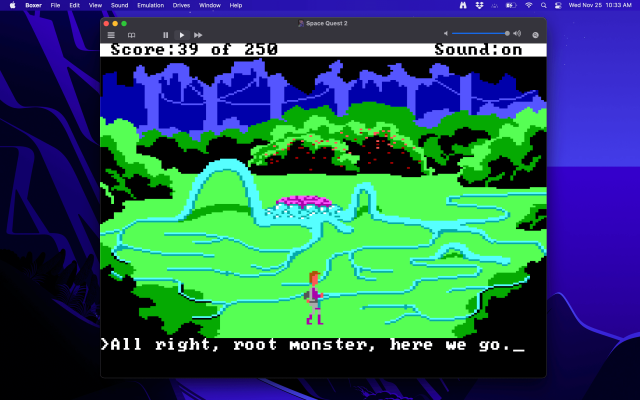
As for running iOS apps on the MBA, I understand it's notionally possible, but I didn't bother. Samuel tried it and had mixed luck, and other reviewers at other sites seem to be having about the same experience. I'm not a mobile app kind of guy, and I only have four that I use regularly—Duo for two-factor authentication, Philips' Hue app for light control, Golf on Mars for wasting time, and 1Password. (Seriously, my phone home screen is two pages, and the only thing on the second page is a folder labeled "Crap" with all the stuff in it that I don't want on the first page and can't delete.)
I have no idea how well Apple Silicon on Big Sur runs iOS apps, and I don't care. For folks wanting to go down that particular path, Samuel's review has you covered—and since there's essentially zero functional difference between how the M1 Air runs iOS apps versus the M1 mini, I anticipate the Air would behave identically to the mini.Form factor, ports, keyboard, screen
Other than the guts, the M1 MacBook Air is pretty much the same device as it is when you buy the Intel-flavored version. The form factor is unchanged. The Air's Retina-resolution screen is the same as it was before the M1 transition—crisp and sharp enough to cut glass. Off-angle viewing looks as good as you would expect it to look, and we measured its maximum brightness at 409 nits. Backlight coverage to my eyes looks even, and I don't see any bleeding at the edges.
Leaving the display behind and turning to the rest of the chassis, the Air's port situation is also the same—the two USB-C plugs support Thunderbolt 3 and USB 3.1 Gen2, and you can connect a single external DisplayPort display that goes up to 6k resolution at 60Hz. Hell, there's even a headphone jack. That's just downright courageous.
-
M1 MacBook Air on top, 2015 Intel MacBook Air on the bottom.Lee Hutchinson
-
I'm really going to miss that SD card reader, too. One more adapter I have to carry.Lee Hutchinson
I missed out on the butterfly keyboard debacle, though I got to experience it vicariously through my Ars coworkers as one by one they all complained in Slack about having to have their butterfly keyboards replaced by Apple. The M1 MBA's "Magic Keyboard" feels more or less the same as my 2015 MBA—perhaps a bit less mushy, but only a small bit. It's perfectly serviceable and unremarkable.
Something I greatly dislike, though, is the removal of the keyboard backlight adjustment keys—they have been replaced by a "start dictation" key and a key that toggles "Do Not Disturb" mode on and off. I'm sure that decision was made after a lot of focus group testing to justify it, but man, it's just powerful annoying to have something you find useful snatched away from you. I find one-touch access to the keyboard backlight to be handy, and I adjust the backlight often. Now the only way to do it is in System Preferences or via a menubar widget. Lame.
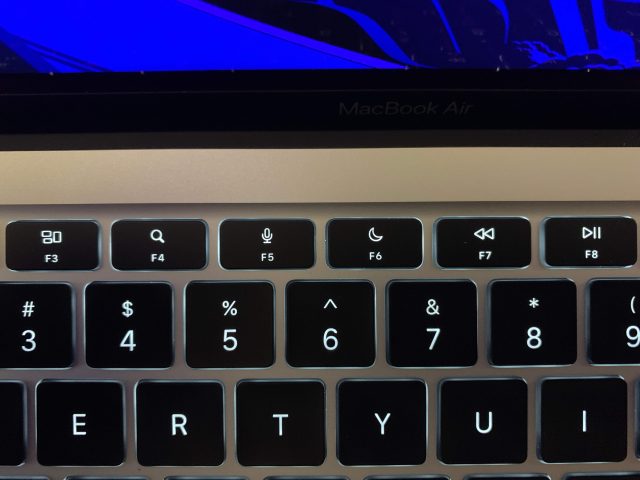
It's a Macbook Air—it's just better than before
Let's back up a bit before we wrap, because I don't want to end the review on a down note. Yeah, USB-C charging sucks compared to MagSafe, and the removal of the backlight keys irks the crap out of me, but to keep things in perspective, I'm excited enough about owning an M1-powered laptop that I dropped a bit over $1,500 of my own dollars on one even though my current laptop was still basically fine.
The new Air's battery life is outstanding, and it feels like I've finally gotten a portable with the endurance I've always wanted. The storage subsystem is quick, load times are minimal, and doing several things on the M1 MacBook Air at once is as quick and responsive as it is when I do the same tasks on my desktop—and my desktop is a Xeon-powered iMac Pro.
I don't like using too many supernals in hardware reviews—at least, in hardware reviews that don't involve flight simulator equipment (for reviews that do involve flight simulator equipment, it's supernals for days!). And while I can't say the M1 MacBook Air is the perfect laptop, I can say that it's excellent.
Seriously, I just wasn't expecting the M1—I wasn't expecting it to be this ludicrously fast for the price and the wattage. I wasn't expecting the new chip to just work—though given Apple's previous architecture switches, I probably should have. I wasn't expecting the Air to kick as much ass as it does. Unlike most portables—including the i7-powered 2015 MBA I'm getting ready to retire—it gets the hell out of my way and doesn't make me wait on it when I want to do something.
It's great. And I'm excited to see what Apple does next.
The Good
- Fast as hell
- Battery lasts a long-ass time
- Common x86 apps seem to work perfectly under Rosetta 2
- To this casual laptop user, the M1 feels pretty dang amazing
- Checks almost every box I care about when it comes to hardware I want to own and use
The Bad
- No keyboard backlight adjustment keys
- You might run into Rosetta compatibility issues with less-common apps
- No Windows virtualization (not yet, at least)
- The loss of MagSafe still stings, even after literally years
The Ugly
- It's such an improvement over Intel-based MacBook Airs that you might find yourself spending a thousand unplanned dollars to join the Apple Silicon club
The bottom line
It's like I said in the beginning of the piece: it's fast. The battery life is great. The M1 seems like a hit, and given Apple's success at iterating on their silicon designs, it seems like things are only going to get faster. If you're looking for a portable, and you're not tied to Windows, the M1 MacBook Air is a pretty damn good use of your money.
Apple’s M1 MacBook Air has that Apple Silicon magic - Ars Technica
Read More
Bagikan Berita Ini

















0 Response to "Apple’s M1 MacBook Air has that Apple Silicon magic - Ars Technica"
Post a Comment